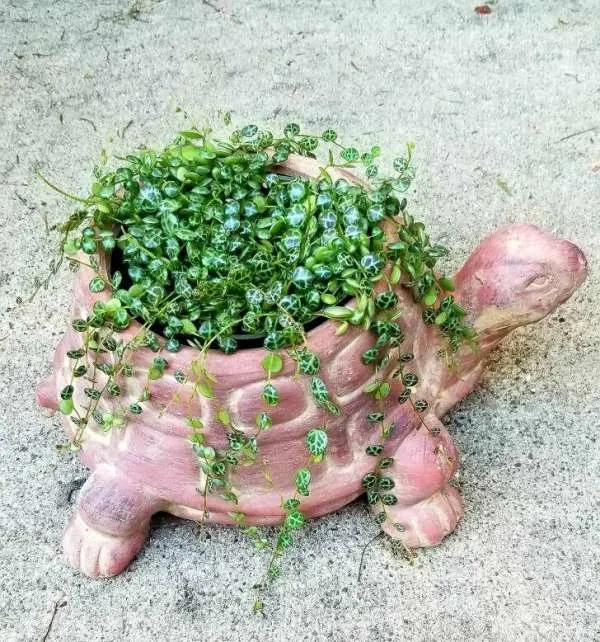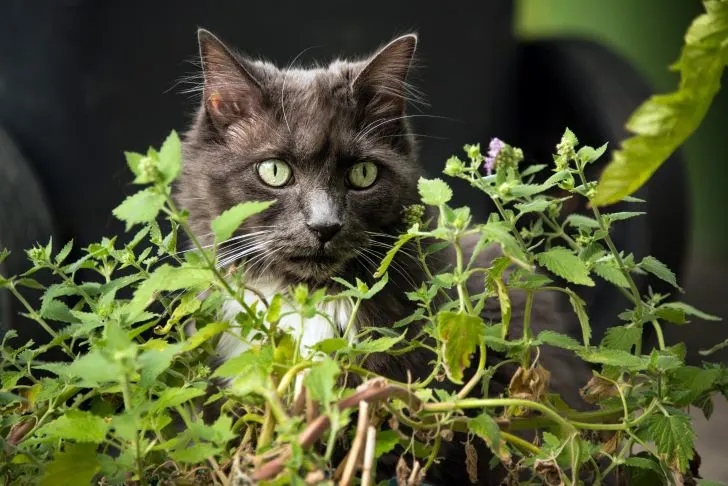As avid plant enthusiasts, we are always looking for unique and exotic greeneries to add to our mesmerizing plant collections. Occasionally, however, we are powerless to house certain plants due to their poisonous nature and potential toxicity.
The String of Turtles, aka Peperomia prostrata, is one such plant.
It is a small, trailing plant native to Central and South America. It is named for its small, round leaves that are shaped like turtle shells and have intricate patterns of green and silver.
Are String of Turtles toxic to cats?
Let’s see!
When it comes to keeping cute little kitties as pets, it’s essential to prioritize their safety. This means doing proper research before bringing new plants into your home.
This article will explore the potential toxicity of the String of Turtles to our feline friends. If it is indeed harmful to cats, we’ll discuss some steps you can take to ensure the safety of your furry companions.
So, without wasting any time, let’s dive in!

Are String of Turtles Toxic to Cats?
It might surprise you, but…
According to the American Society for the Prevention of Cruelty to Animals (ASPCA®), the String of Turtles is non-toxic to cats and dogs.
The NC State University also categorizes the String of Turtles as non-toxic to cats.
So, the question is, if the String of Turtles is non-toxic to cats, why are people so concerned?
The answer lies in the fact that although it is considered “non-toxic” to pets, being a succulent, it can cause symptomatic discomforts—like gastrointestinal irritability, diarrhea, and vomiting—in cats.
Therefore, despite being non-toxic, keeping it away from your cats is better.
Now, let’s see what makes this plant unsafe and what symptoms can lead you to know that your felines have ingested some parts of it.
Why Should You Be Careful?
So far, we’ve discussed that although the String of Turtles is not toxic to cats, it can still be unsafe if ingested.
Why?
Some sources suggest that it is due to the presence of saponins and calcium oxalate crystals in the plant.
Saponins are naturally occurring detergents found in many plants throughout the plant kingdom, and calcium oxalate crystals are known to be found in more than 200 plant families worldwide.
Both compounds are considered toxic to cats.
Symptoms You Should Look For!
If your cat has ingested just a tiny little piece of your plant, it won’t cause any harm.
However, over-indulgence can lead to certain illnesses.
Saponins are known to cause stomach-related problems like vomiting, diarrhea, abdominal pain, lethargy, drooling, and decreased appetite.
On the other hand, calcium oxalate crystals are toxic to cats because they can cause physical irritation and inflammation in the mouth, throat, and gastrointestinal tract when ingested. The crystals can also cause pain and swelling in the mouth, difficulty swallowing, and vomiting.
NOTE: If you see any of the above-mentioned symptoms in your cat, it is essential to contact the veterinarian and seek medical attention as soon as possible.
Are String of Turtles toxic to cats? I hope you now have the answer!
With all that aside, let us look at some ways to deter cats from nibbling on your houseplants.
How to Keep Cats Away From Your Houseplants?
Here are some ways to deter cats from nibbling on your houseplants:
1. Elevate the Plants
Elevating the plants to a certain height where your cats can’t reach them is one of the most straightforward ways of keeping your houseplants safe from these little nibblers.
You can place your plants on high shelves or hang them from ceilings.
Because of its long trailing vines, your String of Turtles will look great if hung from a ceiling.
2. Use Citrus Fruits
Cats do not like citrusy scents.
Therefore, you can use citrus-based cat repellents to keep your little kitties away from your beautiful plants. There is no need to buy commercial deterrents while you can easily make one at home.
- Boil lemon or orange zest in a liter of water.
- Let it brew for about ten minutes, and filter the liquid later on.
- Let the mixture cool down, and you’ll have a potent liquid that will discourage cats from chewing on your plants.
- Once cooled, spray the resulting mixture around your houseplants.
Another easy way to deter cats is to place lemon, lime, or orange peels around the base of your plants.
3. Plant Cat Deterrent Herbs
Aromatic herbs like Lavender, Rosemary, Lemon thyme, Pennyroyal, Citronella, etc., can help deter the cats away due to their strong scents.
You can either plant these herbs near your houseplants, crush and scatter them around the base of your plants, or tie them in bundles and place them in the soil to keep your little furry friends away from your plants.
4. Use Double-Sided Tape
Cats do not like sticky surfaces.
You can place double-sided tape around the base of your plant to keep the cats from accessing them. The tape should be replaced periodically to ensure it remains effective.
5. Make a Physical Barrier
Encircling your plants with a physical barrier like a mesh fence or a wire cage will keep the cats away from them. This method comes in handy if you have a stubborn cat that is difficult to deter using other methods.
6. Provide an Alternative
Lastly, you can provide your cats with other alternatives to keep them away from your desired plants.
These might include cat grass or catnip. Both of these options are safe for cats to chew on and will satisfy their urge to nibble on your houseplants. Keep these plants far from other houseplants to keep the cats away.

That’s all!
Conclusion
It is always important to be vigilant about your cat’s interactions with your plants.
While String of Turtles is generally considered non-toxic to cats, ingesting it in large amounts can still cause symptomatic discomfort in your cute little kitties. Therefore, it is best to take precautions to prevent your cat from nibbling on your plants or to monitor them closely if they do.
By following the tips and methods mentioned earlier, you can create a safe and comfortable environment for both your cat and your houseplants.
That said, let’s finish today’s article.
I hope it helps you a lot!
Regards,
Mahad H.
